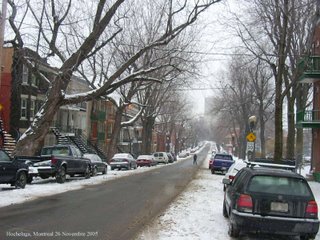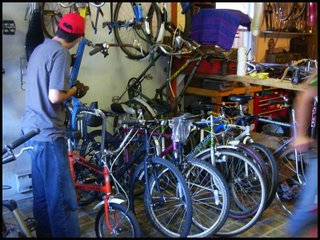
Winter sucks! That's my philosophy anyways, if you're lucky enough to live in the snow belt and want to ride in the snow, read on. I don't snow shoe in the forest, I don't snowboard and I don't ski. I just can't stand winter. My only winter sport is to shovel snow out of my driveway because I'm cheap and it is the only exercise I get in the winter months.
14 years ago, that wasn't the case. I had bought my first brand new bike. It was a store variety cheapo mountain bike with side pull caliper brakes. It wasn't much, but it was a lot better than my old ten speed $15 special from the garage sale. I had moved close to my job at the Fire Department and driving to work was just stupid. I had used the $15 special for the entire summer and I had saved enough cash to buy the new bike. It was in November, by the time I had put the whole thing together that faithful day, wouldn't you know it, it started to snow!
My girlfriend told me that it was too bad I couldn't ride my new bike to work. "No way" I said, "If this thing can climb mountains, it can surely handle a little snow." and that's how 7 straight years of going to work 12 months a year started. This little event also pushed me in the bike repair business, I had to ride in the winter and back then bike shops were closed in the winter. I had to be able to fix my bike myself, so I got educated in the realm of bike repair.
But back to winter riding, this article will be how you can do it for as little money as possible. First thing you need, is a crappy bike. I learned that you must sacrifice a bicycle to the harshness of winter if you don't want to destroy your favorite ride. Winter riding can be hard on you, but your machine is equiped with an exposed drivetrain that has to take a lot of abuse from the elements. In the spring, it won't be pretty. Find an inexpensive bike that you are willing to sacrifice.
The BikeLike I said, the bike you will use to ride in the snow will not have an easy life and its drivetrain will suffer damage even if you are careful. Choose a bike that you don't mind trashing, buy a cheap used one or find one in the trash. Avoid curved racer handlebars, you need to be upright and having an aerodynamic riding position is the least of your concerns.
You will need to put fenders and a rack on that bike. Nothing is worst than riding in cold weather with a wet butt, just make sure that you have plenty of clearance between those fenders and your tires to prevent snow to get packed in there. The rack is necessary to carry your stuff. You need all your skills in snow riding and a backpack will influence your body movements. Put all your gear on the bike so that your body is free to move without any interference.
TiresBig debate here, chains, studs, knobby, skinny, anything goes and I tried most of them. The main problem in the winter is road conditions. Snow and ice are your main enemies. You would need a specific tire for each condition, but that's not really practical.
I never liked skinny tires since they don't seem to grab well in the snow. I have always used a set of mountain bike knobby tires with the tire pressure down 10 lbs from the prescribed maximum. They are good at eliminating snow build-up on the thread and are decent in most conditions.
I made my own studded bicycle tires with a set of almost finished mountain bike tires. I simply drilled holes in the middle and side threads of the tire and applied small steel nuts and bolts. The nut is on the outside of the tire and the inside is covered with duct tape to protect the tube from the head of the bolt. This works very well, but has a drawbacks. Homemade studded tires are HEAVY, this translates into more energy needed to make the bike go forward. Winter is already a pain to pedal your bike anywhere and this added resistance doesn't help at all. I used them for a month and finally went back to the regular knobbies. I figured that for the few times that I needed to ride on ice, it wasn't worth the trouble. I relied on my riding abilities and in the worst cases, I walked my bike home.
LubricationI've tried all sorts of things on my chain and drivetrain to protect them from the elements and nothing is bullet proof. You must wipe down and lube your drivetrain on a regular basis. That's the big secret. Just make sure you use something synthetic and keep the thickness on the light level. Don't forget to lube those exposed brake and derailleur cables. In the spring, change all cables and the chain. If you wait for the Fall to do this, everything will be seized(been there). If they are well lubed, your derailleurs should survive a few seasons, just don't count on this if you have fancy ones, stick with the really cheap stuff.
BrakesWell the best brakes hands down for winter riding are disk brakes. But if you are in a position to trash a disc brake equiped bike for winter riding, you probably don't and drive around in the winter with a big expensive SUV. If you actually do ride a disc brake equiped bike in the winter, I don't have to tell you that you have it made. For the rest of us who have pad to rim brakes, try avoiding chrome steel rims. They are the worst for any knid of wet braking. If you have no other choice, just keep in mind that you will probably have to plan ahead all of your stopping needs!
How to ride in the snow and ice......very carefully. Remember that any time you ride, the actual contact between your bike and the pavement is about the same surface as your thumb. Throw some snow and ice in the mix and it's time to slow things down. Ride slower, don't lean in your turns as much, look ahead and always be conscious of the surface you ride on. This is no time for riding with your mind wandering off somewhere, pay attention! As far as cars go, people will see you most of the time and they are thinking that you are nuts, a bike in the winter is pretty hard to miss.
SafetyA helmet, proper lights, front and back, and a reflective vest are not an option. Do not even consider winter riding without any of these.
ClothingYou don't have to buy expensive winter gear. Just keep in mind that you must put on multiple layers. I had also a good pair of ski gloves and ski goggles with a balaclava(Don't forget to take this off before you go into a store...).
StorageThe best thing to do in the winter is to store your bike inside when you are not using it. Wipe down after everything as melted off. If you are stuck parking it outside, wipe the drivetrain on aregular basis and keep in mind that cables can snap in cold weather. Warm them up before the ride by using them gently a few times before you leave.
In all the years that I rode in the snow, I only fell twice and never broke anything. I loved it and I even preferred it to taking the car when I had the chance. I preferred to get on my bike and be warm within minutes instead of freezing in the car all the way to work. Cold weather, even in the -35C(-30F) range is not that bad. Remember that your worst enemy is the condition of the road surface you're riding on..
Until next time, ride safe and Godspeed.
Gerry




